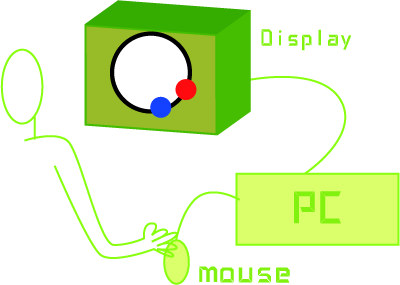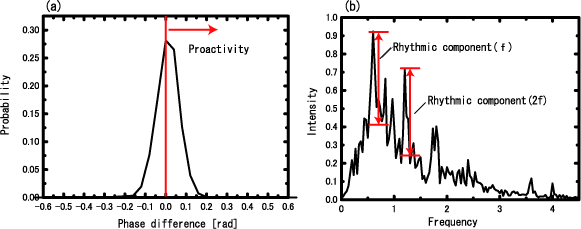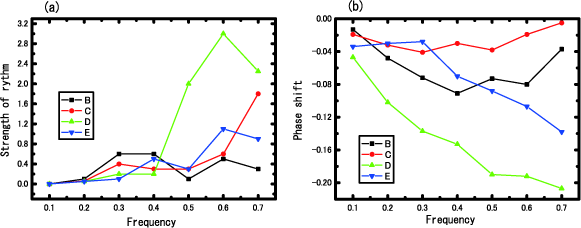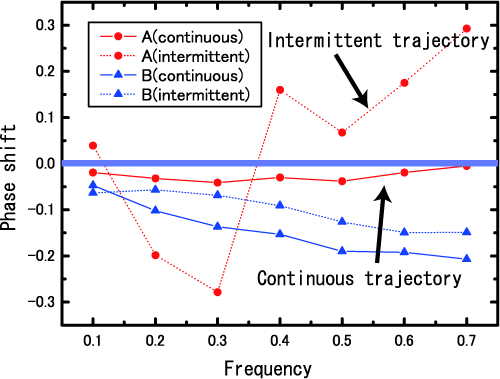Roll of Rhythmic Component in Proactive Control of Human Hand
Yoshikatsu Hayashi^{1,2}, Yurie Tamura^{1,3}, Fumihiko Ishida^4, Ken Sugawara^3, Yasuji Sawada^2
1 Department of Research and Developement NPO natural science
2 Tohoku Institute of Technology
3 Department of Liberal arts, Tohoku Gakuin University
4 The University of Electro-Communications
Abstract
Evolutionally, the strategy of catching prey should have been important to survive in constantly changing environment. Prediction mechanism should have developed to compensate the delay of sensory-motor system. In previous study, "proactive control" was found, in which motion of hands preceded the virtual moving target. The results implied that the positive phase shift of the hand motion represents the proactive nature of the visual-motor control system to minimize the transient error of the hand motion when the target changes unexpectedly. In our study, visual target moves in circle (13cm in diameter) in computer screen, and each subject is asked to keep track with the target motion in circle by the motion of a cursor. As frequency of target increases, rhythmic component in velocity of cursor was found in spite of the fact that velocity of target is constant. The generation of rhythmic component cannot be explained by only feedback mechanism for the phase shift of target and cursor in sensory-motor system. Therefore, it implies that rhythmic component was generated to predict the velocity of target, which is feed forward mechanism in sensory-motor system. In presentation, we discuss the generation of rhythmic component and its roll in feed forward mechanism.
1 Introduction
Evolutionally, the strategy of catching prey should
have been important to survive in constantly
changing environment. Prediction mechanism
should have developed to compensate the delay of
sensory-motor system. In previous study, "proactive
control" was found([1],[2]), in which motion of
hands preceded the virtual moving target. The results
implied that the positive phase shift of the
hand motion represents the proactive nature of the
visual-motor control system to minimize the transient
error of the hand motion when the target
changes unexpectedly.
In this paper, we studied the enhancement of
proactivity by discretization of visual information
in human visual-motor system by performing hand
tracking experiments. The results showed that the
magnitudes of the phase difference of the hand motion
with respect to the target motion increased
when the target is shown intermittently. As frequency
of target increases, rhythmic component in
velocity of cursor was found in spite of the fact that
velocity of target is constant. The generation of
rhythmic component cannot be explained by only
feedback mechanism for the phase shift of target
and cursor in sensory-motor system. Therefore, it
implies that rhythmic component was generated to
predict the velocity of target, which is feed forward
mechanism in sensory-motor system. In this research,
we discuss the generation of rhythmic component
and its roll in feed forward mechanism.
2 Method and Analysis

Figure1: Schematic picture of the hand tracking experiment
A subject was seated at 50cm in front of computer
screen, and was asked to trace a moving visual
target (red circle of 6mm diameter) as accurately
as possible by the motion of a cursor (blue circle of 6mm diameter) in the screen produced
by hand motion through a mechanical computer
mouse(Fig.1).
Experiments are performed in two conditions;
in a first condition, target in circle trajectory is
shown continuously, in a second condition, target
is intermittently shown, i.e., the target is shown for
only 40 percenct of trajectory. subject first follow
the moving target, and when the target disapears,
subject has to follow the circle line in a process of
guessing target velocity and position. We analyze
following physical quantities;
1. Phase shift between target and tracer
2. Velocity of tracer as a function of time
3. Frequency analysis of tracer velocity
3 Results and Discussion

Figure2: (a) Distribution of phase shift (b) Frequency analysis of tarcer velocity
Proactivity of hand motion is caluculated as follows.
Distribution of phase shift between target
and tracer is fitted by gaussan distribution and center
of gaussin function is obtained. To find rhythmic
component of hand motion, frequency analysis
is performed on velocity of tracer. The strength of
rhythmic component was measured by a height of
peak as shown in Fig.2.

Figure3: In continuous trajectory of target (a) The strength of rhythmic component as a function of frequency (b) Proactivity as a function of frequency
In a first experimental condition when the target was shown continuously in circle orbital, Rhythmic component in hand movement was enhanced as the frequency of target increases(Fig.3). However, phase shift was negative in all frequency; hand motion of the subject delayed the target motion. In a second condition when the target was shown intermittently, one subject showed proactivity( Fig.4), i.e., hand motion of the subject preceded the target motion. In the inter-stimulusinterval( when the target is not shown), correction motion to decrease phase shift between target and tracer can not perform(feed-back mechanism), thus, only feed-forward mechanism in which the velocity of target is estimated would work. In this case, the strengh of rhythmic component increased, thus the rhythmic component might play a role in feed-forward mechanism. These considerations indicate that proactivity emerges when feed-forward mechanism works more than feed-back of position correction. In the presentation, we would like to talk about detail analysis based on the emergence of rhythmic component and its roll in feed forward mechanism in visual-motor system.

Figure4: Proactivity as a function of frequency in two experimental condition
References
- [1] F. Ishida and Y. Sawada: Human hand moves proactively to the external stimulus: An evolutional strategy for minimizing transient error. Physical Review Letter, 93, 168105 (2004)
- [2] J. R. Carl and R. S Gellman: Human smooth pursuit: stimulus-dependent responses. Journal of Neurophysiology, 57, 1446/1463 (1987).























